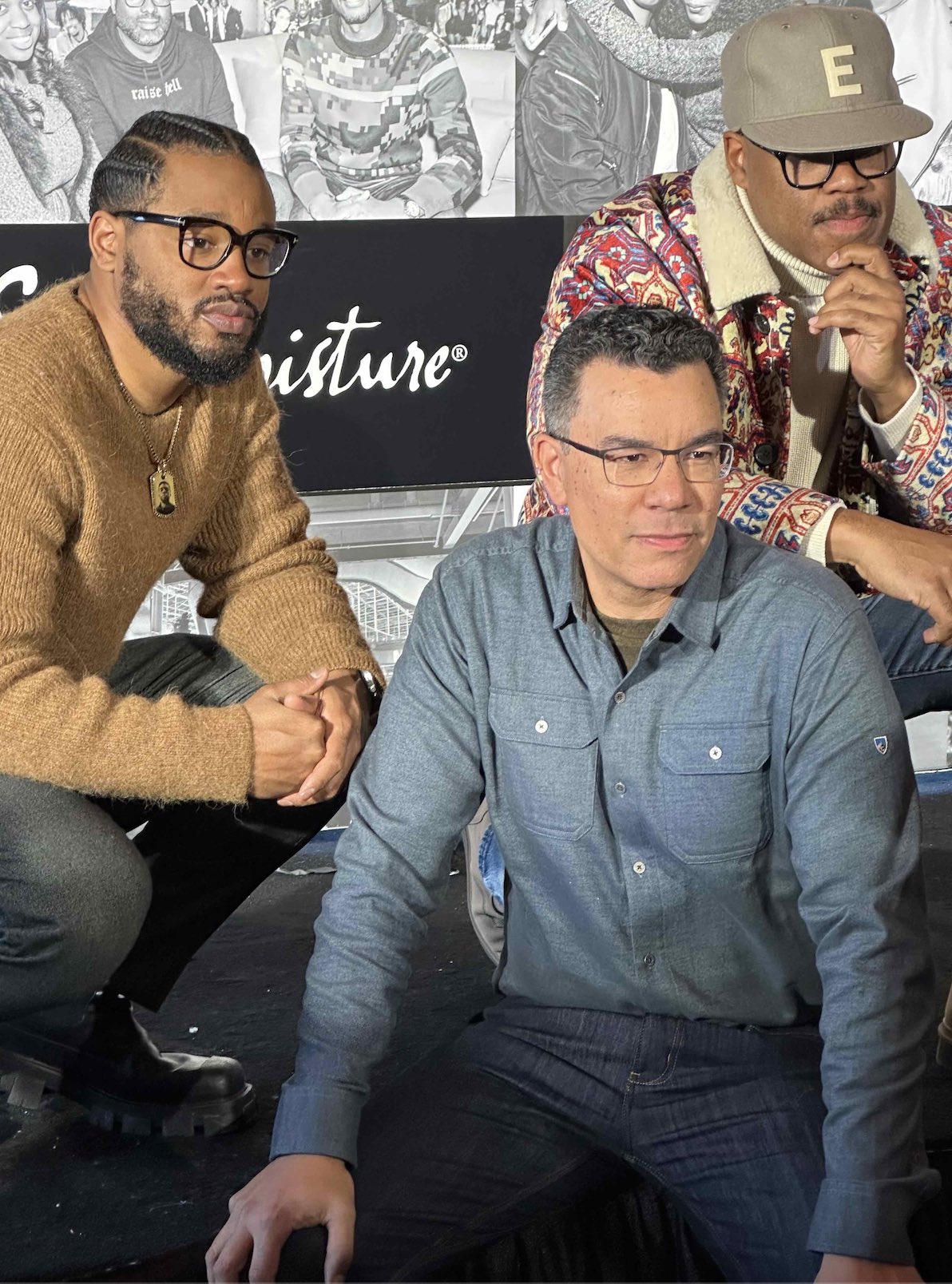Warning: This article contains SPOILERS for Ryan Coogler’s ‘Sinners’!
As I settled into my seat for a Tuesday afternoon showing of Sinners, I expected the typical empty theater experience that weekday matinees usually offer. I was pleasantly surprised to find myself among fellow horror enthusiasts, and even more shocked to see people lining up for the next showing as I left. This, my friends, is how you know a horror film has struck a nerve. (Cover Photo Credit: Featureflash Photo Agency/Paul Smith/Shutterstock.com)
As a lifelong horror devotee who’s witnessed everything from the slasher renaissance to found footage fatigue, I can confidently say that Sinners is exactly the jolt our beloved genre needed. Ryan Coogler has crafted something that feels both familiar and entirely fresh – giving me major From Dusk Till Dawn vibes while carving its own bloody path. And it’s no wonder, as Coogler said he drew inspiration from Robert Rodriguez’s cult classic film.
Plot: Blood Ties and Musical Salvation
Sinners transports us to 1932 Mississippi, where identical twin brothers Smoke and Stack (both brilliantly played by Michael B. Jordan) return to their hometown to open a juke joint – a beacon of hope in Depression-era Mississippi. The twins assemble a colorful cast of characters to run their establishment: veteran musician Delta Slim (Delroy Lindo), Chinese shopkeepers Grace and Bo Chow (Yao and Li Jun Li), bouncer Cornbread (Omar Benson Miller), Smoke’s estranged wife Annie (Wunmi Mosaku), and their cousin Sammie (Miles Caton), a gifted guitarist. The ensemble is completed by captivating singer Pearline (Jayme Lawson) and Stack’s ex-girlfriend Mary (Hailee Steinfeld), who passes for white in their segregated community.
What begins as a journey of redemption quickly descends into a nightmare when the brothers discover an even greater evil awaiting their return. Despite warnings from Sammie’s preacher father, the juke joint’s electric opening night features Sammie’s transcendent playing, which unknowingly summons spirits from both past and future. His mesmerizing chords entrance the crowd – and attract unwanted attention from a group of vampires led by the ruthlessly charismatic Remmick (Jack O’Connell), an ancient Irish vampire with an obsessive fascination for Sammie’s extraordinary musical abilities.
The film’s climax ignites into a visceral and emotionally intense fight for survival as Remmick’s vampire coven unleashes its terror upon the juke joint. The stakes soar as your favorite characters face imminent danger, forcing them to confront not only the external evil but also their own deep-seated wounds. The third act culminates in a bloody, revenge-filled ambush that will leave you simultaneously cheering and heartbroken, a testament to the film’s powerful emotional core and thrilling conclusion.
But that’s not it. Before you rush out when the credits roll, know that Sinners includes two additional scenes – a substantial mid-credits sequence that hints at a possible (and I emphasize the word “possible”) sequel, and a brief post-credits stinger featuring a familiar musical motif. While these scenes might suggest openings for sequels or prequels, I personally feel Sinners works perfectly as a standalone experience. Not every horror film needs to launch a franchise, and there’s something refreshing about a complete story that is well told.
The brilliance of Sinners lies in how Ryan Coogler elevates it beyond typical vampire fare. This isn’t just a horror film about bloodsuckers – it’s a profound exploration of family bonds, hope in darkness, vengeance against injustice, and the power of music. Coogler masterfully weaves these threads together, creating a new kind of horror film that resonates with both die-hard horror fans and those new to the genre.
Cast & Direction: Coogler Steps Into Horror’s Spotlight
Ryan Coogler, known for Black Panther and Creed, makes a spectacular horror debut that begs the question: Is Coogler following in Jordan Peele’s footsteps by laying the groundwork as our next great horror auteur? Based on Sinners, the answer is a resounding yes.

Coogler’s writing and direction shows remarkable restraint for a first-time horror filmmaker. He builds tension methodically, allowing the dread to accumulate rather than relying on cheap jump scares. His camera work in the roadhouse performances is particularly impressive, creating a hallucinatory effect that blurs the line between performance and possession.
Michael B. Jordan delivers a tour-de-force dual performance that showcases his remarkable range, portraying twins Smoke and Stack. Newcomer Miles Caton delivers a beautiful performance as the twins’ cousin Sammie, bringing a lovable innocence and yearning to the role that makes you root for him. Jack O’Connell is near perfect as the film’s antagonist Remmick, infusing his Irish vampire character with an unsettling charm and ancient menace, almost making you feel sorry for him.

For me, three characters truly stole the film. Delroy Lindo, who’s been acting since the late 70s in a wide range of movies like Ransom, The Devil’s Advocate, and This Christmas, portrays the wise-cracking town drunk and blues player Delta Slim. Lindo brings a vulnerability that makes Slim deeply likable—you want to both shake the alcohol out of him and pity him at the same time.
Then there’s Wunmi Mosaku’s portrayal of Smoke’s estranged wife Annie. Yes, she’s the beloved Marvel actress from Loki, Deadpool and Wolverine, and the short-lived Lovecraft Country. Annie shines as the strong spiritual healer and Hoodoo priestess whose occult practices caused marital strife after failing to save their infant daughter. Mosaku reveals Annie’s many layers through a commanding screen presence. Through her eyes, we see she carries the weight of a thousand ancestors on her shoulders, yet also emits a maternal warmth and compassion that exude through the screen.
You will fall in love with Annie, just as the other characters do. Even Mary, after being turned into a vampire, unleashes a blood-curdling scream in agony after witnessing Annie’s life being taken away. Annie had made Smoke promise to kill her if she was ever bitten, rather than living as a vampire. As tears streamed down my face, my heart broke along with Smoke’s as I watched him kill his beloved Annie.
Both Lindo and Mosaku slayed (I had to do it) in this film, but there was one character who physically moved me… The music.
Music: The Heartbeat of Horror
The music in Sinners isn’t just a plot element—it emerges as the film’s most resonant character and symbol, functioning as both weapon and salvation. From the opening scene, we are shown the power that music wields, personified through Sammie’s ability to channel ancestral connections through his blues. One of my favorite scenes in the film is when Sammie begins to play at the club. His music is hypnotic and so powerful that it opens a portal to forbidden fruit, seducing Remmick.

The score by Ludwig Göransson (reuniting with Coogler for the sixth time) serves as a cultural legacy. It brilliantly weaves together blues, hip-hop, traditional African rhythms, combined with Irish and Asian influences to create something that feels both ancient and contemporary. In Coogler’s vision, this musical legacy becomes the ultimate power that can’t be drained away—a heritage that continues reverberating across generations.
Symbolism: More Than Monsters
Like the best horror films, Sinners dives below the surface, using the supernatural to amplify very real themes. Coogler masterfully weaves powerful symbolism throughout its vampire narrative, creating a haunting meditation on freedom. Set in Mississippi’s Delta in 1932—barely two generations removed from slavery’s end—the film exposes how sharecroppers remained tethered to the same cotton fields their ancestors worked, their documented freedom merely an illusion. Through the journey of Smoke and Stack, we witness how true liberation requires not just physical freedom but ownership of one’s cultural identity and creative expression.
The juke joint serves as a luminous symbol of hope amid Depression-era Mississippi’s bleakness. This sawmill-turned-sanctuary represents a rare space where Black residents can drink, dance, and express themselves without judgment. Coogler transforms this gathering place into more than just entertainment—it becomes a spiritual communion where music transcends circumstances. Through Sammie’s guitar playing, the joint becomes a temporary paradise where the community finds collective joy and respite from outside oppression, demonstrating how art creates freedom when physical liberty is constrained.
Box Office Success: Horror Brings Audiences Back
This year’s Oscars broadcast carried a clear message: it’s time to reignite the magic of the movie theater. The pandemic significantly altered film consumption habits, with Variety reporting over 5,700 movie theater closures since its onset. As studios increasingly opted for direct-to-streaming releases, the number of frequent moviegoers declined sharply, raising the crucial question -will people return to the movies?
I think the answer is “yes.” As of May 7, Sinners has grossed $247.7 million worldwide, with numbers expected to increase as the upcoming Memorial Day weekend draws nearer. In fact, viewers are going to theaters more than once to see this movie. Sinners also proves that horror movies are a draw for moviegoers and can bring box office success. This film joins the ranks of recent horror hits like the Terrifier franchise, which has grossed over $102.8 million worldwide, in demonstrating horror’s power to draw audiences back to theaters.
Verdict: A New Horror Classic
Sinners isn’t just a great horror film – it’s a great film, PERIOD. Ryan Coogler has crafted something that honors horror traditions while pushing the genre forward, delivering a story that will satisfy hardcore fans while offering enough substance to attract viewers who might normally avoid horror.
In an era of endless sequels and reboots, Sinners proves original horror can still thrive on a grand scale. If you count yourself among the horror faithful or simply appreciate bold, original filmmaking, make your way to the theater. This is the kind of movie that demands to be experienced in the dark, among fellow viewers who are equally likely to gasp, scream, or applaud at the twisted brilliance unfolding before them.
Sinners is calling. Will you answer?









